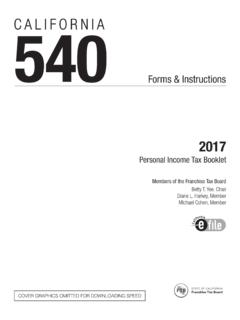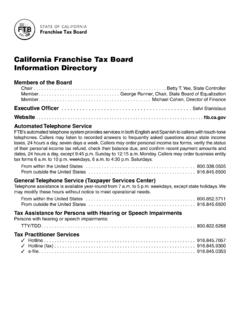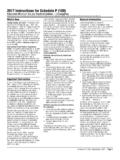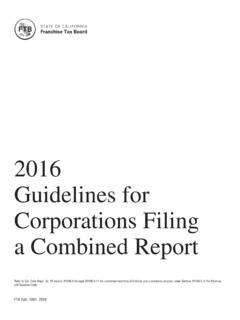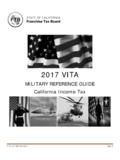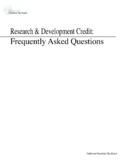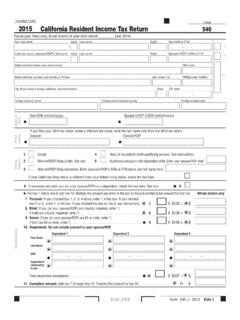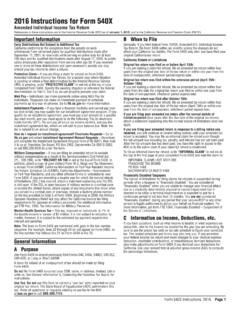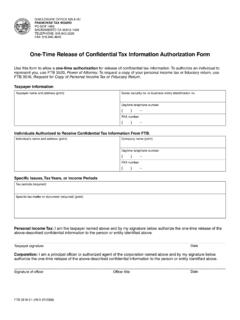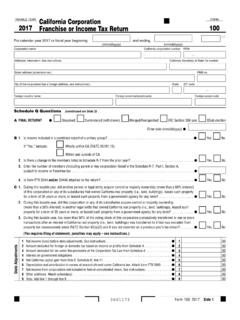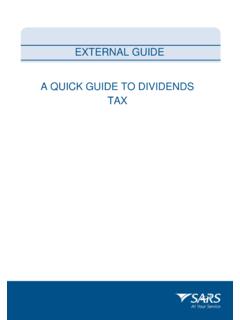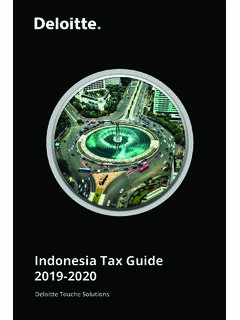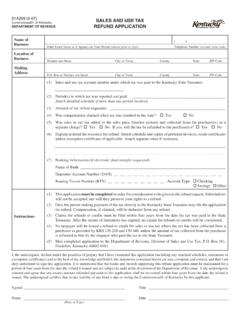Transcription of CHAPTER OF CONTENTS - Franchise Tax Board Homepage
1 CHAPTER OF CONTENTS : 8500 Alternative Minimum Tax 8510 Overview of the AMT Mechanics 8520 AMT Adjustments 8530 Tax Preference Items 8540 Apportionment & Allocation of Pre-adjustment AMTI 8550 Adjusted Current Earnings (ACE) Adjustment 8560 AMT NOL Deduction 8565 Exemption Amount 8570 Tentative Minimum Tax 8575 Interaction With Tax Credits 8580 Minimum Tax Credit 8500 ALTERNATIVE MINIMUM TAX Congress enacted the alternative minimum tax (AMT) as a response to perceived abuses of the tax system.
2 Congress believes that many wealthy taxpayers avoided paying income tax by using exclusions, deductions, and tax credits . The federal AMT addresses this perceived problem by applying a single rate of tax to a tax base, which intends to represent "true economic income." AMT is entirely distinct from, and runs parallel to, the regular tax system. For tax years beginning 2018 and after, corporations are no longer subject to federal AMT. The Tax Cuts and Jobs Act (TCJA) signed into law on December 22, 2017, repealed the federal corporate Alternative Minimum Tax (AMT) and made changes to the rules for Net Operating Losses and the AMT Credit.
3 California law does not conform to the repeal of the federal corporate AMT or to the changes to the NOL and AMT Credit provisions. California taxpayers continue to compute AMT, NOLs, and AMT Credit, in conformity to federal rules as of the specified date of January 1, 2015, with for taxable years beginning on or after January 1, 1988, California substantially conformed to the federal AMT by incorporating with modifications IRC sections 55 - 59. These are contained in R&TC sections 23400-23459. When considering issues in this area, you should always refer to the law for the particular year you are examining to determine the applicable rules for that year.
4 Since the rules are very specific, the manual discussion only provides a general overview of the major AMT provisions and points out significant federal/state differences. 8510 Overview of the AMT Mechanics The AMT provisions create an entire parallel system of taxation that generally targets corporations with Alternative Minimum Taxable Income (AMTI) over $40,000. The AMT is based on AMTI. The basic calculation of the AMT is: Basic AMT Calculation Discussion: Net Income After State Adjustments Adjustments + Preference Items = Pre-Adjustment AMTI before ACE Adjustment and AMT NOL Apportionment provisions are applied.
5 = California pre-adjustment AMTI ACE Adjustment = AMTI before NOL The computation starts with regular California net income after state adjustments. Net income is then reduced or increased by AMT adjustments, and increased by tax preference items to arrive at "pre-adjustment AMTI." At this point, the separate AMTI amounts of the members of a unitary group are combined, and apportionment and allocation procedures are applied to arrive at the California AMTI. The ACE Adjustment and AMT NOL are applied on an individual taxpayer basis as explained in MATM 8540.
6 - AMT NOL Deduction = AMTI before Exemption - Exemption = AMTI x Tax Rate ( for financial corporations) = Tentative Minimum Tax (TMT) - California Regular Tax = Alternative Minimum Tax A maximum exemption of $40,000 is allowed for each taxpayer. After being reduced by the exemption amount, AMTI is taxed at a ( for financials) rate to determine TMT. If the TMT exceeds the regular tax, the excess is the alternative minimum tax (AMT). The AMT for general and financial corporations represents the incremental portion of the tentative minimum tax (TMT) that exceeds the regular tax.
7 If the regular tax exceeds the TMT, no AMT exists. This concept can be illustrated as follows: Since AMT represents the excess of TMT over the regular tax liability, an increase to regular tax may decrease or possibly eliminate AMT. You need to consider this factor when determining the materiality of an audit issue. Before surveying a return on the assumption that the AMT effect will result in insufficient tax potential, you and your supervisor should consider the fact that the AMT is generally considered a prepayment of tax.
8 In years when the TMT exceeds the regular tax, a minimum tax credit is generated because AMT was paid. See MATM 8580. That credit can be carried forward to offset the regular tax in years when the regular tax exceeds TMT. Although increasing the regular tax and reducing AMT may not result in a material tax effect in the current year, the minimum tax credit carried over to subsequent years will be reduced. This may have a substantial effect in future years. By the time that the minimum tax credit is used, the SOL for the year of the income adjustments may have expired.
9 If an NPA or NPACA (see MAP ) has not been issued, we may be barred from revising the amount of the minimum tax credit carryover. See MATM 9010. 8520 AMT Adjustments IRC 56, which California incorporates with modifications in R&TC 23456, requires taxpayers to treat certain items differently in the calculation of alternative minimum taxable income (AMTI) than those items would be treated in the calculation of regular taxable income. Depreciation: For AMT purposes, most property placed in service after 1986 must be depreciated using the methods described in IRC section 56(a).
10 Generally, real property is depreciated using the straight-line method over a specified life. Personal property that has not been depreciated under the straight-line method for regular tax purposes must generally use the 150 percent declining balance method for AMT purposes, changing to the straight-line method in the first year in which the straight-line method yields a higher deduction. The AMT adjustment is the difference between the depreciation deduction computed under the AMT method and the depreciation computed for regular tax purposes.
